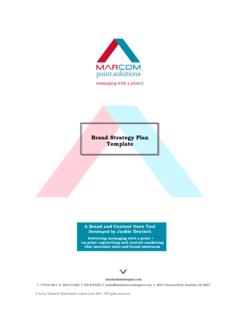Transcription of FAO STRATEGY ON CLIMATE CHANGE
1 Rome, July 2017 FAO STRATEGY ON CLIMATE CHANGE2 MYANMARC arrying a sack of fertilizer distributed by FAO as part of a project to support sustainable livelihoods for flood-affected communities in the Sagaing region. FAO/H. LatCOVER PHOTOGRAPHS: FAO/Joseph Agcaoili FAO/Christena Dowsett FAO/Giuseppe Bizzarri3 ContentsACRONYMS AND ABBREVIATIONS Page 4 FOREWORD Page 6 EXECUTIVE SUMMARY Page 8 INTRODUCTION Page 11 The agricultural sectors, the Paris Agreement and beyond Page 11 CLIMATE CHANGE impact - food and agriculture Page 13 SECTION 1 CLIMATE WORK AT FAO Page 14 Evolution Page 14 Vision Page 15 Approach Page 15 SECTION 2 GUIDING PRINCIPLES Page 17 Give precedence to food security, poverty reduction and sustainability Page 17 Leave no one behind Page 17 Support policy integration and mainstreaming Page 17 Promote evidence-based, scientific approaches Page 18 Promote ecosystem-based approaches Page 18 Learn from experience Page 18 Lead by example Page 18 Measure and evaluate impact Page 18 SECTION 3 EXPECTED OUTCOMES Page 19 Outcome 1.
2 Enhanced capacities of Member Nations on CLIMATE CHANGE through FAO leadership as a provider of technical knowledge and expertise Page 19 Outcome 2. Improved integration of food security and nutrition, agriculture, forestry and fisheries considerations within the international agenda on CLIMATE CHANGE through reinforced FAO engagement Page 19 Outcome 3. Strengthened coordination and delivery of FAO work on CLIMATE CHANGE Page 19 SECTION 4 PLAN OF ACTION Page 20 ANNEX 1: THE IMPACTS OF CLIMATE CHANGE ON THE FOOD AND AGRICULTURAL SECTORS Page 28 Food security Page 28 Nutrition and human health Page 29 The agricultural sectors Page 29 Natural resources Page 31 Post-production stages Page 33 Human migration Page 33 ANNEX 2: ACTION PLAN RESULTS FRAMEWORK Page 36 ANNEX 3: RESOURCE ALLOCATION Page 45 FAO STRATEGY ON CLIMATE CHANGE4 Acronyms and abbreviations AFOLUA genda 2030 CBCCBDCCAMCO2 COP21 COP22 CPFsCSADRRFAOGCFGDPGEFGHGhaIDWG CCIFADA griculture, Forestry and Land Use 2030 Agenda for Sustainable Development FAO CLIMATE and Environment Division (in the CLIMATE , Biodiversity, Land and Water Department)
3 Convention on Biological DiversityClimate CHANGE Adaptation and Mitigation Carbon Dioxide 21st Conference of the Parties to the UNFCCC 22nd Conference of the Parties to the UNFCCC Country Programming Frameworks CLIMATE -Smart Agriculture Disaster Risk Reduction Food and Agriculture Organization of the United Nations Green CLIMATE Fund Gross Domestic Product Global Environment Facility Greenhouse Gas Hectares Interdepartmental Working Group on CLIMATE CHANGE International Fund for Agricultural Development ACRONYMS AND ABBREVIATIONS5 IFIsINDCsIPCCLDCsLLDCsLULUCFMTPNAMAsNAPs NDCNRCPWBSDGsSFMSIDSSPsTNCCCO2e/ha/yearU NUNCCDUNDPUNEPUNFCCCWFPWMOI nternational Financial Institutions Intended Nationally Determined Contributions Intergovernmental Panel on CLIMATE CHANGE Least Developed Countries Land-Locked Developing CountriesLand Use, Land Use CHANGE and Forestry Medium Term Plan Nationally Appropriate Mitigation Actions National Adaptation Plans Nationally Determined Contributions FAO CLIMATE and Environment Division (since December 2016 known as CBC)
4 Programme of Work and Budget Sustainable Development Goals Sustainable Forest Management Small Island Developing States FAO Strategic Programmes FAO Technical Network on CLIMATE CHANGE Tonnes of carbon dioxide equivalent per hectare per year United Nations United Nations Convention to Combat Desertification United Nations Development Programme United Nations Environment Programme United Nations Framework Convention on CLIMATE CHANGE World Food Programme World Meteorological OrganizationFAO STRATEGY ON CLIMATE CHANGE6 FOREWORDFOREWORDF orewordThere is no peace without tackling food security and eliminating hunger and there will be no food without tackling CLIMATE CHANGE . I am convinced that we can end hunger in our lifetime. We have the tools and the know-how. However, the goals and aspirations of the 2030 Agenda for Sustainable Development to end hunger, reduce rural poverty and manage natural resources in a sustainable manner cannot be achieved if temperatures continue to rise.
5 We have a window of opportunity to stabilize global average temperatures to safe levels but we must act now. Now is the time to take action to meet the target included in the Paris Agreement of the UN Framework Convention on CLIMATE CHANGE . That is why CLIMATE action, a cross-cutting theme of FAO s Strategic Framework, is being integrated into every facet of our work, bolstering and building on decades of accumulated global experience and expertise. Agriculture and food systems are partly responsible for increased temperatures but are also a fundamental part of the solution to mitigate greenhouse gas emissions and promote adaptation to a changing CLIMATE , especially for rural family farmers in developing countries. Often the poorest, they are also the most vulnerable to CLIMATE CHANGE . For millions of people, our actions can make a difference between poverty and prosperity, between hunger and food the impacts of CLIMATE CHANGE increase and become more intense, a global transformation to sustainable agriculture must begin immediately.
6 Noting that around 90 percent of the countries CLIMATE commitments, known as Nationally Determined Contributions (NDCs), include the agricultural sectors clearly demonstrates the strong demand from FAO Member Nations for CLIMATE action and also underlines that FAO has a fundamental contribution to considers CLIMATE CHANGE a top-line corporate priority - as reflected in the newly-endorsed STRATEGY on CLIMATE CHANGE where FAO will focus its work on three fronts:First, to enhance institutional and technical capacities of Member , to improve integration of food security, agriculture, forestry and fisheries within the international CLIMATE third, to strengthen internal coordination and delivery of FAO s STRATEGY translates FAO s core mandate into strategic choices and action priorities at global, regional, national and local levels with the central goal of supporting its Member Nations in achieving their commitments to face CLIMATE CHANGE .
7 It will be implemented through FAO s Strategic Framework as well as through strategic partnerships. It is my honour to thank the numerous FAO Member Nations, partners and colleagues who participated in the consultative process that gave way to this first corporate FAO STRATEGY on CLIMATE FOR FAO S WORK ON CLIMATE CHANGEFAO STRATEGY ON CLIMATE CHANGEThe FAO STRATEGY on CLIMATE CHANGE lays out an ambitious way forward that will require a decisive and collaborative effort in the coming years to deliver the transformational solutions that the agricultural sectors offer for CLIMATE STRATEGY is a roadmap for FAO, but also an invitation to you, our partners, to join us in the endeavor to overcome the defining development challenge of our time: to safeguard food security in a changing CLIMATE and to leverage the potential of the agricultural sectors to ensure that CLIMATE CHANGE is limited to levels that still allow Earth s natural systems to Graziano da SilvaDirector-GeneralFood and Agriculture Organizationof the United Nations8 Executive summary Despite the considerable progress being made, humanity s future still hangs in the balance.
8 CLIMATE scientists call attention to two contrasting paths: The business-as-usual path is an unsustainable path whose outcome would be sustained rates of high global warming and, possibly, runaway CLIMATE CHANGE . The sustainable path represents a sustainable future with an average warming of below two degrees Celsius. FAO places sustainability at the core of all that it does, to ensure Earth s mountains, oceans, forests, waters and soils can continue to provide for the 10 billion population that is expected over the next century, and their descendants. 2015 was an extraordinary year of global commitment towards a better future. In September, the international community laid out the vision of a hunger-free, more equitable, sustainable, peaceful and resilient world by creating the 2030 Agenda on Sustainable Development with its 17 Sustainable Development Goals (SDGs).
9 In December, the Paris Agreement on CLIMATE CHANGE pledged to keep global warming well under two degrees Celsius and to create a CLIMATE resilient future. In Addis Ababa, the Action Agenda on financing this demanding, complex and interconnected Agenda was adopted. FAO has actively contributed to these milestones, most recently by highlighting food and agriculture prominently at the 22nd Conference of the Parties (COP22) of the United Nations Framework Convention on CLIMATE CHANGE (UNFCCC) in Marrakech, Morocco. Based on FAO s work for over a decade, the CLIMATE CHANGE STRATEGY has been formulated to focus FAO s work on CLIMATE CHANGE in light of these landmark decisions. Driven by the desire to best serve its Member Nations in achieving their commitments under the Paris Agreement and their priorities under the Sustainable Development Goals, it translates FAO s core mandate into strategic choices and action priorities at global, regional and national levels.
10 The food and agricultural sectors1 are central for human development; they need to be at the centre of the global response to CLIMATE CHANGE . As this STRATEGY shows, the food and agricultural sectors are vulnerable to a most worrying degree and face great challenges in adapting to CLIMATE CHANGE . Support for agriculture, particularly smallholder farmers, is pivotal to achieving SDGs 1 and 22 under a changing CLIMATE . At the same time, the food and agricultural sectors represent enormous potential and opportunities to create synergies between both the CLIMATE and development agenda. FAO can support this development with a wealth of knowledge and suitable tools and advocates for large-scale CLIMATE finance to be funneled into the sectors where investment can lay the groundwork for the paradigm shift needed to achieve the future we envisages a world in which food and agricultural systems and dependent livelihoods have become EXECUTIVE SUMMARY 1 For the purposes of this document, the agricultural sectors are understood to comprise crops, livestock, fisheries and aquaculture, and forestry.















